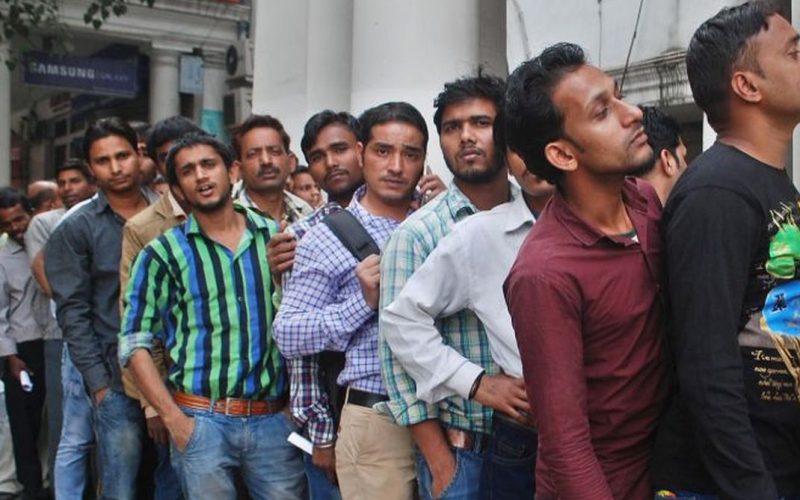India is on track to surpass Japan as the world’s fourth-largest economy by 2025, a year earlier than the International Monetary Fund previously projected. With such growth, one would expect India’s booming economy to be its strongest selling point—but is it?
While everything may appear sound and rosy on paper, a quiet storm is brewing, one that could erupt if not addressed soon- the critical issue of rising unemployment.
The “India Employment Report 2024,” published last month by the International Labour Organization and the Institute for Human Development, found that unemployment is particularly high among India’s youth.
Young Indians between the ages of 15 and 29 accounted for a staggering 83 percent of all unemployed individuals in the country. Worse still, employment is largely concentrated in poor-quality jobs within the informal sector, while wages and earnings are stagnant or declining.
In short, there are not enough jobs, the ones available are of poor quality, and stagnant salaries are burdening households amid rising costs.
Where We Stand
The Centre for Monitoring Indian Economy’s (CMIE) monthly figures reveal a steady and troublingly high unemployment rate throughout the year. The rate spiked to 9.2 percent in June, up from 7 percent the previous month, and after some relief in July, it climbed back to 8.5 percent in August.
This ugly example shows what the population has been voicing for some time – the vast majority of the unemployed are youth, particularly educated young people, and women are even further marginalized.
Likewise, the International Labour Organization’s report revealed that in Jammu and Kashmir, the unemployment rate among educated youth (aged 15–29) jumped from below 22 percent in 2005 to 35 percent in 2022.
The Harsh Reality of Employability
The Annual Status of Education Report (ASER) examines foundational learning outcomes for students aged 14 to 18 years in rural India.
What it revealed is shocking – around 25 percent of this age group still cannot fluently read a standard second-grade text in their regional language, and more than half struggle with division problems expected at the fourth- or fifth-grade level.
How does the current government approach education?
In the most recent Union budget, the allocation for education for FY 2024-25 was 7 percent lower than the revised estimates for the previous year, with higher education seeing a 16 percent budget cut. At the same time, the number of higher learning institutions reportedly increases each year, yet there is little data on the quality of education and the “job-readiness” of graduates.
In fact, the same ASER report found that 80 percent of youth could locate a specific video on YouTube, and nearly 90 percent could share it with a friend. This is a generation equipped with many tech skills but with too few jobs—or the necessary abilities to fill them.

The Overstretch on Startup Inc.
India is surely a land of opposites, where on one hand, there’s the narrative of ‘Shining India,’ where the market capitalisation of listed companies ranks the country fourth globally.
According to the IMF, India’s real GDP growth rate is expected to outperform other emerging-market economies by about 67% in FY25. Robust capital markets, a thriving indigenous PE-VC ecosystem, and regulatory and policy support have ensured the reverse-flipping of India’s Startup Diamonds.
More positive is the belief that this is India’s century which is evident not only in the exuberance of capital markets—with 63 mainboard IPOs in India until September 2024 and 165 SME IPOs by August 2024—but also in the return of Indian startups formerly domiciled abroad.
Government support, such as amendments to the Companies Act in 2017, policy interventions like RBI regulations in 2018, and an investor-friendly environment (with Nifty50 trading at a nearly 89% premium to the MSCI EM index) have given investors confidence for successful exits in today’s market.
At the same time, India has also fostered a strong domestic investor network. A key metric to evaluate the performance of these AIFs is using distributions to paid-in capital (DPI) alongside multiple on invested capital (MOIC). This approach will help improve the quality of fund managers in the ecosystem, creating a multiplier effect on the caliber of founders and innovations that India is backing.
Then, of course, there’s the much-lauded ‘demographic dividend,’ which outlines India’s unique advantage. However, this asset is time-bound, as India is expected to undergo a demographic transition over the next 16 to 36 years. This means India’s opportunity to fully leverage its demographic advantage is limited.
While India can certainly take pride in how far it has come, complacency is a risk. As India Inc. leans heavily on Startup Inc. there is a bot of caution here as over-reliance on startups to project the notional growth of state and central governments may not be the best strategy as valuations often do not accurately reflect the actual revenues of these firms, and this gap could present challenges down the line.
So What Is the Ground Reality?
India’s startup ecosystem is undeniably vibrant, supported by strong capital markets, a growing private equity-venture capital (PE-VC) network, and policy incentives. However, beneath the surface of this optimism lies a complicated and nuanced reality that is often overshadowed by the headline-grabbing IPOs and high valuations.
Startup Boom vs. Economic Reality
India’s startup ecosystem has seen exponential growth over the last decade.
As of 2024, India has 67 unicorns, according to the Hurun India Future Unicorn Index. India is the third-largest hub for unicorns in the world, behind the United States and China.
India produced more offshore unicorns than any other country, co-founding 109 unicorns outside of India compared to 67 in India.
According to a report published in forbesindia.com, as of May 2024, the Indian Startup Ecosystem, ranking third globally in terms of unicorn count, collectively valued at $349.67 billion.
As of September 30, 2024, 62 companies in India have raised Rs 64,477 crore through IPOs, and 165 small and medium enterprises (SMEs) have raised Rs 5,500 crore. The IPO frenzy has also attracted Indian startups previously headquartered abroad to redomicile in India, further Strengthening the notion of economic growth.
However, despite these figures, many startups face significant challenges when it comes to sustainable growth. Several high-profile startups, such as Paytm, Zomato, and Nykaa, have seen their post-IPO performance fall short of expectations. Paytm, for example, which debuted with much fanfare, saw its stock price drop by nearly 70% in its first year of listing, reflecting broader concerns about inflated valuations.
Hence, valuations often do not correspond with actual revenue figures, which raises red flags about the sustainability of these startups in the long term.

Employment and Job Creation, A Disconnect
The startup sector, while creating thousands of jobs, has not managed to keep pace with the larger employment demands of India’s growing workforce.
India’s unemployment rate remains stubbornly high, with the Centre for Monitoring Indian Economy (CMIE) reporting a spike to 9.2% in June 2024. Although this figure dipped slightly to 8.5% in August 2024, it still outlines the serious issue of joblessness in a country with one of the world’s youngest populations.
What is even more concerning is the quality of employment.
A vast proportion of jobs created by startups are in the gig economy, offering limited benefits and job security. According to a report by the International Labour Organisation (ILO) and the Institute for Human Development, 83% of India’s unemployed population consists of people between the ages of 15 and 29. Many of these youth, even with educational qualifications, are trapped in low-paying, precarious jobs that offer little in terms of career progression.
The Informal Sector Conundrum
The informal economy continues to dominate India’s job market, accounting for around 80% of the total employment. Despite the startup surge, most of the country’s workforce remains engaged in the informal sector, where wages are low, and job security is minimal. According to the Economic Survey 2023-24, over 45% of India’s workforce still earns less than ₹375 per day.
While startups have been hailed as engines of job creation, their role in formalizing the Indian job market has been limited. For instance, many startups in sectors like e-commerce and food delivery primarily employ gig workers, where employment is short-term, and benefits like health insurance and pensions are lacking. These jobs, though offering flexibility, do not contribute to long-term economic stability for the workers.
Startup Failures and Market Corrections
The enthusiasm surrounding IPOs has somewhat masked the high failure rate within the startup ecosystem.
Reports suggest that nearly 90% of startups in India fail within the first five years, with issues such as poor product-market fit, cash flow problems, and mismanagement contributing to their downfall. A study by IBM and Oxford Economics found that the lack of innovation and scalability is a significant factor behind the high mortality rate of Indian startups.
In addition, many startups have faced difficulties in raising fresh capital as global economic conditions tighten. Rising interest rates, inflation, and a more cautious investor landscape have led to a slowdown in startup funding. In the first half of 2024, startup funding dropped by nearly 40% compared to the same period in 2023, according to Venture Intelligence. This funding crunch has forced many startups to resort to mass layoffs and scaling back operations, further compounding the unemployment issue.
The ‘Demographic Dividend’ Dilemma
India’s much-touted demographic dividend—a young and growing workforce—has been presented as a key driver of its future economic growth. However, the benefits of this demographic advantage are fleeting, and the window of opportunity is narrowing. According to a United Nations report, India is expected to reach its demographic peak by 2040, after which its population will begin to age rapidly.
The challenge is that while India’s workforce is growing, the economy is not generating enough quality jobs to absorb this influx.
Moreover, cuts in education spending have compounded the problem. In the FY 2024-25 budget, education spending was reduced by 7%, with the higher education sector seeing a 16% cut. This reduction in funding is concerning given that higher education is critical for nurturing the skilled workforce that India needs to sustain its economic momentum.
Snapshot
Unemployment, The Elephant In The Room
While India’s startup ecosystem shines brightly, the ground reality paints a more complicated picture. High unemployment, underemployment, and the informal nature of much of the job market remain significant challenges. Additionally, the over-reliance on startups as indicators of economic health can be misleading, as valuations often fail to reflect underlying business fundamentals.
For India to fully capitalize on its demographic dividend and avoid overextending its reliance on the startup sector, a more balanced approach is necessary like focusing on creating more formal, high-quality jobs across sectors, invest in education to enhance employability, and foster innovation that drives sustainable, long-term growth.
We are sitting on a time bomb that is set to explode sooner than we think, hence it is critical that the problem of rising unemployment is addressed heads on before it is to late!









